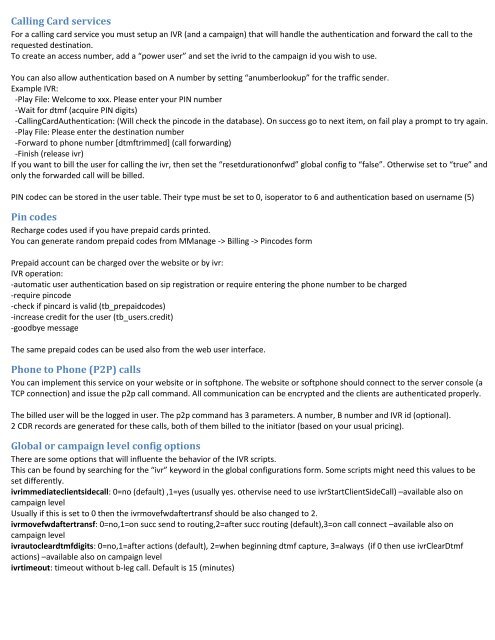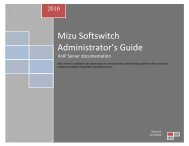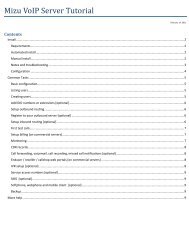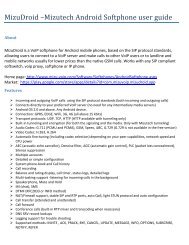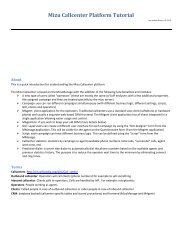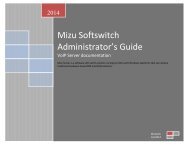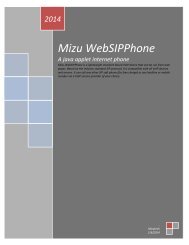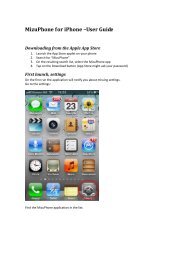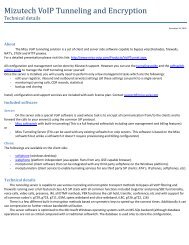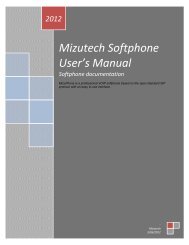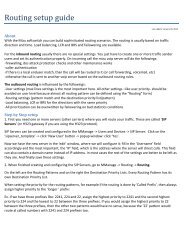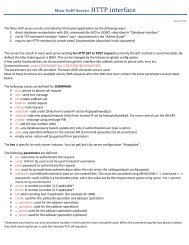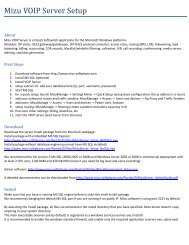Calling Card servicesFor a calling card service you must setup an <strong>IVR</strong> (and a campaign) that will handle the authentication and forward the call to therequested destination.To create an access number, add a “power user” and set the ivrid to the campaign id you wish to use.You can also allow authentication based on A number by setting “anumberlookup” for the traffic sender.Example <strong>IVR</strong>:-Play File: Welcome to xxx. Please enter your PIN number-Wait for dtmf (acquire PIN digits)-CallingCardAuthentication: (Will check the pincode in the database). On success go to next item, on fail play a prompt to try again.-Play File: Please enter the destination number-Forward to phone number [dtmftrimmed] (call forwarding)-Finish (release ivr)If you want to bill the user for calling the ivr, then set the “resetdurationonfwd” global config to “false”. Otherwise set to “true” andonly the forwarded call will be billed.PIN codec can be stored in the user table. Their type must be set to 0, isoperator to 6 and authentication based on username (5)Pin codesRecharge codes used if you have prepaid cards printed.You can generate random prepaid codes from MManage -> Billing -> Pincodes formPrepaid account can be charged over the website or by ivr:<strong>IVR</strong> operation:-automatic user authentication based on sip registration or require entering the phone number to be charged-require pincode-check if pincard is valid (tb_prepaidcodes)-increase credit for the user (tb_users.credit)-goodbye messageThe same prepaid codes can be used also from the web user interface.Phone to Phone (P2P) callsYou can implement this service on your website or in softphone. The website or softphone should connect to the server console (aTCP connection) and issue the p2p call command. All communication can be encrypted and the clients are authenticated properly.The billed user will be the logged in user. The p2p command has 3 parameters. A number, B number and <strong>IVR</strong> id (optional).2 CDR records are generated for these calls, both of them billed to the initiator (based on your usual pricing).Global or campaign level config optionsThere are some options that will influente the behavior of the <strong>IVR</strong> scripts.This can be found by searching for the “ivr” keyword in the global configurations form. Some scripts might need this values to beset differently.ivrimmediateclientsidecall: 0=no (default) ,1=yes (usually yes. othervise need to use ivrStartClientSideCall) –available also oncampaign levelUsually if this is set to 0 then the ivrmovefwdaftertransf should be also changed to 2.ivrmovefwdaftertransf: 0=no,1=on succ send to routing,2=after succ routing (default),3=on call connect –available also oncampaign levelivrautocleardtmfdigits: 0=no,1=after actions (default), 2=when beginning dtmf capture, 3=always (if 0 then use ivrClearDtmfactions) –available also on campaign levelivrtimeout: timeout without b-leg call. Default is 15 (minutes)
ivrtimeout2: timeout if there was a b-leg call. Default is 40 (minutes)maxivrloop: max ivr action in one session (default is 500)Banivrauth: 0=no,1=callbacks,2=all (default; check max failed ivr pincode)Maxivrauthfail: maximum number of failed authentication requestststorecscriptanswers: set to 1 to store the <strong>IVR</strong> script path that was traversed by the usersivrauthentication: how to authenticate the users on the <strong>IVR</strong>. See the Admin guide for the details.ivrbilling: default is 5. See the Admin guide for the details.Ivrfwduser: how to rewrite the A number on authentication: 0=userid is pincode callernumber is orig caller (default), 1= userid ispincode callernumber is pincode,2=orig callerIvrplaybackstopondtmf: 0=no,1=terminate playback on ivrWaitForDTMF,2=terminate playback on all,3=terminate playback andskip all playback (default)Playivrfwdringtone: 0=no,1=on ring received if other player is not playing (default),2=on ring received always,3=fakeUseivrreinvite: wheter to send back a reinvite to offload the media routing (not supported by many devices)Freeivraccess: 0=no (default),1=callback,2=ivr,3=ivr+callbackIvrdtmfmethod: dtmf method to be generated by the ivr when needed: 0=inband,1=info,2=inband+info,3=RFC2833,4=RFC2833 andinfo,5=inband, RFC2833 and info,6=inband, RFC2833 or infoMaxivrthreads: how much tread to be allowed for the <strong>IVR</strong>Ivrthreadtreshold: how much tread to be allowed for the <strong>IVR</strong> (threshold for a new thread)Technical descriptionOn routing if calleduser.ivrid > 0 than set ep ivr_id and calltype to eIvrNo other ep will be createdivr_id is the campaignidOn invite (after routed) if calltype = eIvr () call IvrAction(actIvrStart);IvrAction(EIvrActionType actiontype)1. the actiontype will tell what was happened: actDefault, actIvrStart, actReady, actUserInput, actTimeout, actFail2. load the scripts if already not loaded3. Check next action todo (jumpto). Especially check for dtmf input actiona. if actiontype == actUserInput than check if input finished (eof or maxlen)b. if play finished and need to repeat, than play againc. otherwise set jumpto4. JumpTo next action if needed (check enterconditions)5. execute the next action (datainputtype, if any)Play file, execute sql, forward, etcNotes-For skill based callcenters you can use the “Forward to Group” or the “Forward to SQL” actions.-You can assign an <strong>IVR</strong> menu to any user if you set the “ivrid” field to a valid campaignid id.-<strong>IVR</strong>s are directly mapped to campaigns and can be edited in the script editor. Set your CampType to 2 (<strong>IVR</strong> IN) if you have assignedto an <strong>IVR</strong>.-If you need something to do between the call forward and the server side call, then you should set the ivrmovefwdaftertransf to 2and the ivrimmediateclientsidecall to 0 and then use the “Initiate client side call” <strong>IVR</strong> action to actually send the call.-Multiple languages can be easily implemented (using Conditional SQL and SetLanguage actions)-Any kind of voicemail system can be implemented with the voicemail and recording actions. You might prefer to modify one of theexisting templates than build from scratch-List answers will be separated by semicolon ;-All script answers (including data input) can be saved to tb_ccscript_processing and used for further statisticsFor more details, please consult the Admin Guide.For more help, contact serversupport@mizu-voip.com.Copyright © 2006-2014 <strong>Mizu</strong>Tech SRL


